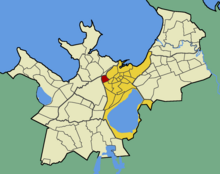Kassisaba

Kassisaba (German "Katzenschwanz") is a district ( Estonian asum ) of the Estonian capital Tallinn . It is located in the Kesklinn district ("inner city").
Description and history
Kassisaba has 3,384 inhabitants (as of May 1, 2010).
In the Tallinn city fortification system, the raised, fortified corner points of the entrenchments were called cats . The paths leading out of the fortress from there were called cat's tails . The name of the area was first used as an official name in 1732. From 1348 to 1870 Kassisaba was a suburb of Tallinn Toompea and was subject to its law.
In the 17th century a summer farm for the local aristocracy was established. In 1792 Louise von Steinheil was its owner; after her the area was also called Luisenthal .
From 1652 to 1710 there was a hospital for the poor in Kassisaba, which was founded by Queen Christina of Sweden . From 1705 it served as a military hospital for the Swedish army. It was probably set on fire by Russian troops when they captured Tallinn.
In 1725, the Toom-Vaestekool ( Toom-Vaestekool ) school for the poor and orphans of the Tallinn cathedral parish was founded in Kassisaba, teaching in both German and Estonian. A new school building was built in 1867. The school stayed there until 1917.
In the 18th century, simple, single-storey wooden houses with adjacent gardens were built in the area. From 1772 to 1782 there was a famous faience manufacture founded by the Stralsund pharmacist Carl Christian Fick. For this purpose he had recruited masters from Germany, mainly from Kiel . The basic material for Ficks faience was the indigenous bluish clay, which was mixed with imported white clay. The blanks were provided with a thick white tin oxide glaze and painted with muffle paints.
In the 19th century it was the old man Hans Heinrich Falck (1791–1874) who played a significant role in the expansion and beautification of the district. Falck had a public park built in the middle of the 19th century. The park has been named Falgi park in his honor since 1989 .
With the construction of the railway line from the Baltic Sea port of Paldiski to Tallinn and the growing industrialization of the Estonian capital, more and more residential buildings have been built in Kassisaba since the 1870s. Most of the old wooden houses were also preserved during the interwar period .
Parts of Kassisaba were destroyed in the devastating bomb attack by the Soviet Air Force on Tallinn in March 1944. Modern buildings in the Stalin style were built there during the Soviet occupation of Estonia .
photos
Main building of the Estonian constitutional protection Kaitsepolitseiamet
View of the Karlskirche (Kaarli kirik)
Web links
- History of Kassisaba (Estonian)
Individual evidence
- ↑ Archived copy ( Memento of the original from May 17, 2011 in the Internet Archive ) Info: The archive link was inserted automatically and has not yet been checked. Please check the original and archive link according to the instructions and then remove this notice.
- ↑ http://www.postimees.ee/110806/esileht/siseuudised/tallinn/212753.php ( page no longer available , search in web archives ) Info: The link was automatically marked as defective. Please check the link according to the instructions and then remove this notice.
- ↑ http://linnamuuseum.ee/linnamuuseum/en/collections/#ceramics
- ↑ Archived copy ( memento of the original from October 29, 2012 in the Internet Archive ) Info: The archive link was inserted automatically and has not yet been checked. Please check the original and archive link according to the instructions and then remove this notice.
Coordinates: 59 ° 26 ' N , 24 ° 44' E








